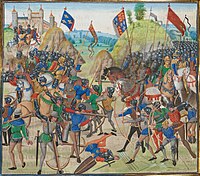
Jean de Waurin or Wavrin was a medieval French chronicler and compiler, also a soldier and politician. He belonged to a noble family of Artois, and witnessed the Battle of Agincourt from the French side, but later fought on the Anglo-Burgundian side in the later stages of the Hundred Years' War. As a historian he put together the first chronicle intended as a complete history of England, very extensive but largely undigested and uncritical. Written in French, in its second version it extends from 688 to 1471, though the added later period covering the Wars of the Roses shows strong bias towards Burgundy's Yorkist allies. Strictly his subject is Great Britain, but essentially only England is covered, with a good deal on French and Burgundian events as well.
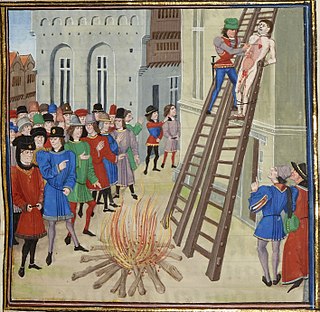
Froissart's Chronicles are a prose history of the Hundred Years' War written in the 14th century by Jean Froissart. The Chronicles open with the events leading up to the deposition of Edward II in 1326, and cover the period up to 1400, recounting events in western Europe, mainly in England, France, Scotland, the Low Countries and the Iberian Peninsula, although at times also mentioning other countries and regions such as Italy, Germany, Ireland, the Balkans, Cyprus, Turkey and North Africa.

Louis de Bruges, Lord of Gruuthuse, Prince of Steenhuijs, Earl of Winchester, was a Flemish courtier, bibliophile, soldier and nobleman. He was awarded the title of Earl of Winchester by King Edward IV of England in 1472, and was Stadtholder of Holland and Zeeland 1462–77.
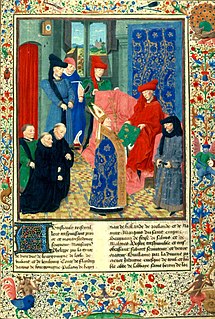
Simon Marmion was a French and Burgundian Early Netherlandish painter of panels and illuminated manuscripts. Marmion lived and worked in what is now France but for most of his lifetime was part of the Duchy of Burgundy in the Southern Netherlands.

Antoine de Bourgogne, known to his contemporaries as the Bastard of Burgundy or Le grand bâtard, was the natural son of Philip III, Duke of Burgundy, and one of his mistresses, Jeanne de Presle. He was comte de La Roche (Ardenne), de Grandpré, de Sainte-Menehould et de Guînes, seigneur de Crèvecoeur, Beveren et Tournehem, and chevalier of the Golden Fleece.

The Getty Tondal, also known as Les visions du chevalier Tondal is an illuminated manuscript from 1475, now in the Getty Museum. It is a French version and is the only surviving fully illuminated manuscript of the Visio Tnugdali. It has 20 miniatures by Simon Marmion and elaborate borders with "CM" for the initials of Margaret of York, Duchess of Burgundy and her husband Charles the Bold. The text was scribed by David Aubert in Ghent, while the miniatures were done in Valenciennes, where Marmion was based. Only the fifteen pages with two-column miniatures and five pages with single column miniatures have borders. There are only 45 folios, meaning that most have miniatures. The manuscript is fully available online.
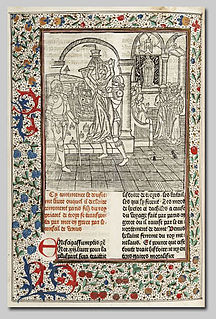
Colard Mansion was a 15th-century Flemish scribe and printer who worked together with William Caxton. He is known as the first printer of a book with copper engravings, and as the printer of the first books in English and French.
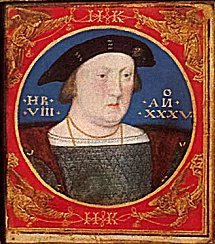
Lucas Horenbout, often called Hornebolte in England (c.1490/1495–1544), was a Flemish artist who moved to England in the mid-1520s and worked there as "King's Painter" and court miniaturist to King Henry VIII from 1525 until his death. He was trained in the final phase of Netherlandish illuminated manuscript painting, in which his father Gerard was an important figure, and was the founding painter of the long and distinct English tradition of portrait miniature painting. He has been suggested as the Master of the Cast Shadow Workshop, who produced royal portraits on panel in the 1520s or 1530s.

David Aubert was a French calligrapher who transcribed and adapted courtly romances and chronicles for the court of the Duke of Burgundy. In addition to finely presented works, illuminated at Bruges and other centres, for the Dukes Philip the Good and Charles the Bold and the Duchess Margaret of York, he completed manuscripts for Antoine de Bourgogne and Philippe de Croy.

The Master of Anthony of Burgundy was a Flemish miniature painter active in Bruges between about 1460 and 1490, apparently running a large workshop, and producing some of the most sophisticated work of the final flowering of Flemish illumination. He was first identified by Winkler in 1921; his name is derived from one of his most elevated patrons, Anthony of Burgundy, Philip the Good's illegitimate son, though he also worked for the Dukes and other bibliophiles in Burgundian court circles, who had already been allocated "Masters" by art historians. His contributions to the heavily illustrated Froissart of Louis of Gruuthuse from the early 1470s, on which several of the leading illuminators of the day worked, show him excelling some more famous names, like Loiset Lyédet. The young Master of the Dresden Prayer Book worked as his assistant on this book, suggesting he was an apprentice; a number of other anonymous masters have been postulated as his pupils. Other works are in the libraries of Paris, Wrocław, Philadelphia, Munich, Cambridge University Library and elsewhere.

Jean Miélot, also Jehan, was an author, translator, manuscript illuminator, scribe and priest, who served as secretary to Philip the Good, Duke of Burgundy from 1449 to Philip's death in 1467, and then to his son Charles the Bold. He also served as chaplain to Louis of Luxembourg, Count of St. Pol from 1468, after Philip's death. He was mainly employed in the production of de luxe illuminated manuscripts for Philip's library. He translated many works, both religious and secular, from Latin or Italian into French, as well as writing or compiling books himself, and composing verse. Between his own writings and his translations he produced some twenty-two works whilst working for Philip, which were widely disseminated, many being given printed editions in the years after his death, and influenced the development of French prose style.

The Master of James IV of Scotland was a Flemish manuscript illuminator and painter most likely based in Ghent, or perhaps Bruges. Circumstantial evidence, including several larger panel paintings, indicates that he may be identical with Gerard Horenbout. He was the leading illuminator of the penultimate generation of Flemish illuminators. The painter's name is derived from a portrait of James IV of Scotland which, together with one of his Queen Margaret Tudor, is in the Prayer book of James IV and Queen Margaret, a book of hours commissioned by James and now in Vienna. He has been called one of the finest illuminators active in Flanders around 1500, and contributed to many lavish and important books besides directing an active studio of his own.

The Rothschild Prayerbook or Rothschild Hours, is an important Flemish illuminated manuscript book of hours, compiled c. 1500–20 by a number of artists.

Engelbert II of Nassau, Engelbrecht in Dutch, was count of Nassau and Vianden and lord of Breda, Lek, Diest, Roosendaal, Nispen and Wouw. He was a soldier and courtier, for some time leader of the Privy council of the Duchy of Burgundy and a significant patron of the arts.

The Hours of Mary of Burgundy is a book of hours, a form of devotional book for lay-people, completed in Flanders around 1477. It was probably commissioned for Mary, the ruler of the Burgundian Netherlands and then the wealthiest woman in Europe. No records survive as to its commission. The book contains 187 folios, each measuring 225 by 150 millimetres. It consists of the Roman Liturgy of the Hours, 24 calendar roundels, 20 full-page miniatures and 16 quarter-page format illustrations. Its production began c. 1470, and includes miniatures by several artists, of which the foremost was the unidentified but influential illuminator known as the Master of Mary of Burgundy, who provides the book with its most meticulously detailed illustrations and borders. Other miniatures, considered of an older tradition, were contributed by Simon Marmion, Willem Vrelant and Lieven van Lathem. The majority of the calligraphy is attributed to Nicolas Spierinc, with whom the Master collaborated on other works and who may also have provided a number of illustrations.

Jean Wauquelin presenting his 'Chroniques de Hainaut' to Philip the Good is a presentation miniature believed to have been painted by the Flemish artist Rogier van der Weyden. It decorates the frontispiece to the Chroniques de Hainaut, MS KBR.9242, Jean Wauquelin's French translation of a three-volume history of the County of Hainaut originally written in Latin by the 14th-century Franciscan historian Jacques de Guyse.

A presentation miniature or dedication miniature is a miniature painting often found in illuminated manuscripts, in which the patron or donor is presented with a book, normally to be interpreted as the book containing the miniature itself. The miniature is thus symbolic, and presumably represents an event in the future. Usually it is found at the start of the volume, as a frontispiece before the main text, but may also be placed at the end, as in the Vivian Bible, or at the start of a particular text in a collection.

The Book of Hours of Engelbert of Nassau is a book of hours in the Dominican Rite, illuminated by the Master of Mary of Burgundy, which was produced in Ghent in the 1470s or 1480s for Engelbert II of Nassau. It is regarded as one of the high-points of Flemish manuscript illumination.

The Chronicles of Hainaut is an illuminated manuscript in three volumes, tracing the history of the county of Hainaut up to the end of the 14th century. Its text was produced around 1446-1450 by Jean Wauquelin as a French translation of Annales historiae illustrium principum Hannoniæ, a three-volume Latin work produced by Jacques de Guise around 1390-1396. It was made for Philip the Good of Burgundy and is now in the Bibliothèque royale de Belgique in Brussels.

The Master of Margaret of York is the Notname of an illuminator active in Bruges between 1470 and 1480. He owes his name to a devotional book he decorated for Margaret of York, wife of Charles the Bold, Duke of Burgundy. A large number of his illuminated books were executed for Louis de Gruuthuse. Several manuscripts have also been attributed to his assistants.






